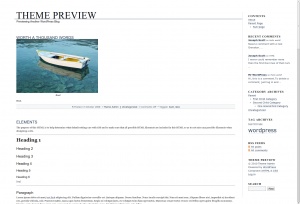Fluidizer fixed width → fluid width bookmarklet 14 July 2010


This is another old one, something I made february fifteenth of this year.
One of the purely theoretical things that have always annoyed me, were fixed width themes. Because I love being a hypocrite, this blog right now is using a fixed width theme. Though I probably could make up an excuse, like to serve as a decent test case for Fluidizer in part of my grand scheme detailed via embedded steganographic messages inside all of my screenshots. Of course that’s all a lie (however much I would like otherwise).
It’s always bothered me how some web sites have these fixed-width layouts, sometimes with insanely thin boxes allocated to content. The vast majority of my screen becomes this orange blob of text. Chrome’s visual appearance motto is “Content not chrome”. That doesn’t help if the content is being obscured by the presentation of the content (gopher) might have solved that problem). Less chrome just means my eyes start to drown in +/- 1,732,405 pixels of orange. Even outside the extreme case, having a fixed-width layout isn’t efficient, and using something like Readability to only show the content removes the personality of the site or author, and only works on articles.
Fluidizer automatically resizes themes semi-pseudo-intelligently, and works with a lot of themes. It has several algorithms it uses, which are sort of alchemy-like and strange. I have no clue how it works, but there’s lots of strange stuff that goes on to magically do stuff. I think it even somehow has a CSS parser that uses CORS to load css through a server-side proxy.
Only tested in Chrome: [Fluidize]
javascript:(function(){function k(a){return(a||"").replace(/^\s+|\s+$/g,"")}function u(a,g){var b=new XMLHttpRequest;b.open("GET","http://anti15.chemicalservers.com/cssproxy.php?cssurl="+encodeURIComponent(a),true);b.onreadystatechange=function(){b.readyState==4&&b.status==200&&g(b.responseText)};b.send()}function o(){for(var a=0,g=0,b=false,h="*,div,p,body,span".split(",");!b&&g++<20;){if(document.body.scrollWidth>window.innerWidth){b=true;a-=100}else a+=100;for(var c=d.length;c--;){var f=d[c].text;try{for(var i=document.querySelectorAll(f),l=i.length;l--;){var n=i[l],p=parseFloat(d[c].width,10),q=d[c].width.replace(/^[\-\d\.]+/,"");if(q!="px")if(q=="em")p*=16;else console.warn("not used to handling non-px units");if(p>400&&h.indexOf(f)==-1){if(!n.a)n.a=p;n.style.width=n.a+a+"px"}}}catch(x){}}}try{c=d.length;a=0;for(var r;c--;)if(h.indexOf(d[c].text)==-1)try{var j=document.querySelectorAll(d[c].text);if(j.length==1&&j[0].getElementsByTagName("*").length>15&&(j[0]==document.body||j[0].parentNode==document.body||j[0].parentNode.parentNode==document.body))if(parseInt(d[c].width,10)>a){a=parseInt(d[c].width,10);r=j[0]}}catch(y){}if(a>500)r.style.width="100%"}catch(z){}}function v(a){function g(){var i=h.split(";").map(function(l){if(k(l.split(":")[0])=="width")return k(l.split(":")[1]);return""}).join("");b&&k(b)&&i&&k(i)&&d.push({text:k(b),width:i});h=b=""}for(var b="",h="",c=0,f=0;f<a.length;f++)if(a[f]=="{")c=1;else if(a[f]=="}"){g();c=0}else if(c==0)b+=a[f];else if(c==1)h+=a[f];g();o()}for(var d=[],s=document.styleSheets,t=s.length;t--;){var e=s[t];if(e.href&&!e.cssRules){console.log(e.href);u(e.href,v)}else{e=e.cssRules;for(var m=e.length;m--;){var w=e[m].selectorText;e[m].style&&e[m].style.width&&d.push({text:w,width:e[m].style.width})}}}window.addEventListener("resize",function(){setTimeout(function(){o()},100)});o()})();